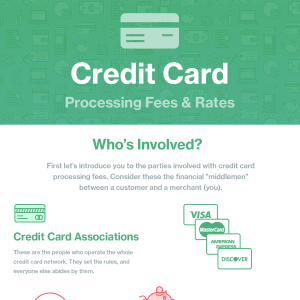Find out what a convenience fee is, how the fee works, and what the rules are for implementing one with your credit card sales.
Our content reflects the editorial opinions of our experts. While our site makes money through
referral partnerships, we only partner with companies that meet our standards for quality, as outlined in our independent
rating and scoring system.
Convenience fees are a way for businesses to recoup payment processing costs. But charging convenience fees may deter some customers. How do you know if it’s the right choice for you?
If your business has started accepting new payment methods for the convenience of your customers, you may be considering charging convenience fees to keep costs down.
This guide takes a deep dive into convenience fees, including how convenience fees differ from surcharges, credit card convenience fee rules, and how to notify customers that your business charges convenience fees.
What Is A Convenience Fee?
A convenience fee is a fee charged by a business when a customer makes a payment via a non-standard payment method. Convenience fees are most commonly charged for online, phone, or credit card payments. Convenience fees may be charged either as a flat fee or a percentage of the transaction.
Although both are used to help businesses cover the cost of credit card processing fees, convenience fees and surcharges are distinct from one another. Surcharges are specific to credit cards, while convenience fees are charged when a customer chooses to pay with a credit card rather than a “preferred” standard method such as cash or ACH.
How Does A Convenience Fee Work?
Convenience fees are most commonly applied to payments such as utilities, rent, tuition, government fees (e.g., motor vehicle registration fees), and even taxes. All these fees tend to be traditionally payable by check or in person, so payment online by a credit card is an added convenience.
For example, a customer may be charged a convenience fee when purchasing a movie ticket online, as movie theaters usually sell tickets at the box office. When the movie theater owner chooses to offer an alternate way to buy tickets via online sales, customers are required to pay with a credit card. The theater can then charge a convenience fee for online purchases because those who do not wish to pay the convenience fee can always buy in person at the box office.
There are rules for how you can charge a convenience fee, and they differ with every card.
Visa has the most thorough policy on the subject, while Discover and American Express are rather vague and rely on broader rules that apply to how merchants accept card payments in general.
Convenience Fees VS Surcharges
Like a convenience fee, a credit card surcharge is another way to offset credit card processing fees. A surcharge is not the same as a convenience fee, though they are often confused with each other.
Generally, a surcharge is added to a product or service’s regular price when a customer pays with a credit card. It can be applied to all credit card payments for a specific card or to specific categories of products. You do not need primary or secondary payment channels to institute surcharges, which makes things a bit simpler.
However, not every state allows surcharges. The rules related to surcharges are complex, so be sure to speak to your credit card acquirer to make sure you follow all the rules before you start charging this fee.
How To Charge Convenience Fees: Payment Card Rules
To charge convenience fees, you’ll need to comply with convenience fee regulations. Each credit card company has its own rules on charging convenience fees, and they all encourage merchants to speak to their card acquirer when considering adding a convenience fee. As convenience fee rules are subject to change, it’s best to work with your credit card processor to ensure compliance.
Below, we will go through the rules implemented by Visa, Mastercard, Discover, and American Express so you can have a better idea of what you might have to do to charge a convenience fee.
Visa
According to Visa’s website:
In certain countries, for example Russia, the U.S., and some countries in Asia, a merchant is permitted to charge a convenience fee to the customer. The fee must be a flat fee (not a percentage of the transaction amount), clearly disclosed, and represent payment for the convenience of paying through an alternate payment channel (such as online) that is different than the merchant’s normal payment channel (for example sending a check through the mail or paying in person).
In general, Visa convenience fees must be charged at a flat rate, clearly disclosed, and be charged because it provides a bonafide convenience to the cardholder. Visa’s convenience fee regulations can be found in Visa’s most recent Core Rules Document (Section 5.5.2).
If your business is in the US, here are some major items of note when implementing a convenience fee for Visa cards:
- Can only be charged in a card-absent environment (phone, online, mail order, etc.).
- Cannot be charged if you are solely an online merchant (if you are, then consider a surcharge).
- Must be charged as a bona fide convenience, not just for the card’s acceptance.
- Must only be charged by the merchant providing the good or service to the cardholder.
- Must disclose clearly and give the cardholder a chance to cancel the payment before paying.
- The fee must be included in the total amount of the transaction and not charged separately
- Applicable to all forms of payment accepted in the payment channel.
- The fee must be a flat or fixed amount, regardless of the value of the payment due.
- Cannot charge for recurring transactions or installment transactions.
- Cannot charge both a convenience fee and a surcharge.
If you wish to implement a convenience fee for Visa cards, we encourage you to read Section 5.6.2 of the Visa rules and work with your processor.
If you’re a service business and wish to charge a service fee instead of a convenience fee, Visa does allow such charges for some MCC codes.
Mastercard
Generally, Mastercard allows convenience fees, but only for government and education entities. Specifically, convenience fees are allowed only in connection with these types of payments:
- Tuition and school-sponsored room and board for elementary schools, secondary schools, colleges, universities, and professional schools.
- Government and court fees, costs, and fines, including alimony and child support payments.
- Local, state, and federal taxes.
There are some additional rules under the Mastercard Convenience Fee Program. They include:
- If you charge a convenience fee for American Express, Discover, and Visa, then you must treat Mastercard in the same way you treat these other cards.
- There are additional electronic data security standards that you may have to adhere to.
- The cardholder must be notified of the additional convenience fee and be given a chance to back out of paying this way.
Finally, Mastercard recommends that the convenience fee be charged separately from the actual payment. This is the opposite of the Visa requirement. Fortunately, it is not a mandatory rule.
If you are a government or education entity and wish to charge a convenience fee for Mastercard payments, contact your acquirer and work with them on the details.
American Express
American Express does not seem to have a policy on convenience fees, but it does not prohibit its merchants from charging them either. According to the American Express Merchant Operating Guide, you can charge a convenience fee as long as:
- The fee fits the definition of a convenience fee (as opposed to a surcharge),
- You do not discriminate against the use of the American Express card,
- You disclose that the fee is to cover your administrative costs, not to cover your cost of accepting the card, and
- You disclose the fee to the cardholder and give the cardholder a chance to back out.
The safest approach for adding American Express to your convenience fee program is to speak to your credit card acquirer. But as long as you meet Visa’s requirements, you should also satisfy American Express’s.
Discover
Like American Express, Discover does not seem to have a rule on convenience fees.
Because there are no clear, stated rules on convenience fees, the only other consideration is Section 2.4 of Discover’s Merchant Operating Regulations R11.1. This rule requires the merchant to not discriminate against the use of the Discover card, similar to American Express’s policy. If you don’t charge a convenience fee for Visa but assess one for Discover, you would be in violation of this rule.
From a practical standpoint, if you use the Visa rules and just add Discover card as a payment option, you should be satisfying Discover’s requirements for convenience fees. However, you should always check with your processor to ensure compliance.
ACH Payments
Most ACH payments run through the ACH Network operated by Nacha. But, unlike the credit card networks, Nacha hasn’t provided guidance on convenience fees. As far as we can tell, various state and federal laws (if you’re in the US) may regulate convenience fees for ACH payments. This means that the rule might not be uniform.
If you wish to charge a convenience fee for ACH payments, we recommend you work with your processor. They might have best-practice suggestions for you to follow so you won’t run into trouble with state laws.
Example Credit Card Convenience Fee Notice
Here’s an example of a convenience fee charge notice for US-based businesses:
CONVENIENCE FEE NOTICE: The option to pay [YOUR BUSINESS NAME] via [PAYMENT METHOD] is provided to you for your convenience. If you proceed to checkout, you will be charged a convenience fee of [INSERT AMOUNT]. This fee is added to the total charge for the goods/service you purchased today. If you do not wish to pay this fee, please click “cancel” below to return to the previous page. You may pay us by [CHECK, ACH, IN PERSON] without incurring this convenience fee.
As Visa has the most detailed requirements for convenience fees, this notice adheres to Visa’s regulations. As such, this notice should satisfy the rules imposed by other card networks. Generally, where a convenience fee is allowed (US, Asia Pacific), there’s no strict wording requirement for the notice itself (excluding Russia).
Are Convenience Fees The Right Choice For Your Business?
Convenience fees are used to help reduce costs associated with payment processing but can only be used when there is another “standard” way for the customer to pay. If you wish to impose a convenience fee, contact your credit card acquirer. They can help you follow all the rules from the credit card companies as well as tell you how much you can charge for the fee.
However, it’s important to keep in mind that we are moving toward a society where most customers don’t carry cash and businesses are implementing entirely cashless payment systems. Charging a convenience fee may drive away customers or entice them, depending on the circumstances. For example, many people might be happy to pay a small fee to renew their driver’s license online, but might be put off if a restaurant charges a 4% convenience fee to pay with a card.
Before you start charging a convenience fee, be sure there is a demand for it, or you might end up with an alternate payment method that no one uses.











